be quiet! SFX L Power 600W PSU Review
Why you can trust Tom's Hardware
Transient Response Tests
Advanced Transient Response Tests
For details on our transient response testing, please click here.
Ιn these tests, we monitor the SFX L Power 600W's response in several scenarios. First, a transient load (10A at +12V, 5A at 5V, 5A at 3.3V, and 0.5A at 5VSB) is applied for 200ms as the PSU works at 20 percent load. In the second scenario, it's hit by the same transient load while operating at 50 percent load.
In the next sets of tests, we increase the transient load on the major rails with a new configuration: 15A at +12V, 6A at 5V, 6A at 3.3V, and 0.5A at 5VSB. We also increase the load-changing repetition rate from 5 Hz (200ms) to 50 Hz (20ms). Again, this runs with the PSU operating at 20 and 50 percent load.
The last tests are even tougher. Although we keep the same loads, the load-changing repetition rate rises to 1 kHz (1ms).
In all of the tests, we use an oscilloscope to measure the voltage drops caused by the transient load. The voltages should remain within the ATX specification's regulation limits.
These tests are crucial because they simulate the transient loads a PSU is likely to handle (such as booting a RAID array or an instant 100 percent load of CPU/GPUs). We call these "Advanced Transient Response Tests," and they are designed to be very tough to master, especially for a PSU with a capacity of less than 500W.
Advanced Transient Response at 20 Percent – 200ms
| Voltage | Before | After | Change | Pass/Fail |
|---|---|---|---|---|
| 12V | 12.253V | 12.116V | 1.12% | Pass |
| 5V | 5.045V | 4.915V | 2.58% | Pass |
| 3.3V | 3.366V | 3.258V | 3.21% | Pass |
| 5VSB | 5.001V | 4.907V | 1.88% | Pass |
Advanced Transient Response at 20 Percent – 20ms
| Voltage | Before | After | Change | Pass/Fail |
|---|---|---|---|---|
| 12V | 12.252V | 12.068V | 1.50% | Pass |
| 5V | 5.045V | 4.905V | 2.78% | Pass |
| 3.3V | 3.365V | 3.225V | 4.16% | Pass |
| 5VSB | 5.001V | 4.869V | 2.64% | Pass |
Advanced Transient Response at 20 Percent – 1ms
| Voltage | Before | After | Change | Pass/Fail |
|---|---|---|---|---|
| 12V | 12.251V | 12.059V | 1.57% | Pass |
| 5V | 5.045V | 4.912V | 2.64% | Pass |
| 3.3V | 3.366V | 3.242V | 3.68% | Pass |
| 5VSB | 5.001V | 4.887V | 2.28% | Pass |
Advanced Transient Response at 50 Percent – 200ms
| Voltage | Before | After | Change | Pass/Fail |
|---|---|---|---|---|
| 12V | 12.209V | 12.070V | 1.14% | Pass |
| 5V | 5.018V | 4.918V | 1.99% | Pass |
| 3.3V | 3.343V | 3.238V | 3.14% | Pass |
| 5VSB | 4.955V | 4.873V | 1.65% | Pass |
Advanced Transient Response at 50 Percent – 20ms
| Voltage | Before | After | Change | Pass/Fail |
|---|---|---|---|---|
| 12V | 12.208V | 12.025V | 1.50% | Pass |
| 5V | 5.018V | 4.868V | 2.99% | Pass |
| 3.3V | 3.342V | 3.211V | 3.92% | Pass |
| 5VSB | 4.955V | 4.837V | 2.38% | Pass |
Advanced Transient Response at 50 Percent – 1ms
| Voltage | Before | After | Change | Pass/Fail |
|---|---|---|---|---|
| 12V | 12.207V | 12.006V | 1.65% | Pass |
| 5V | 5.018V | 4.865V | 3.05% | Pass |
| 3.3V | 3.342V | 3.191V | 4.52% | Pass |
| 5VSB | 4.955V | 4.833V | 2.46% | Pass |

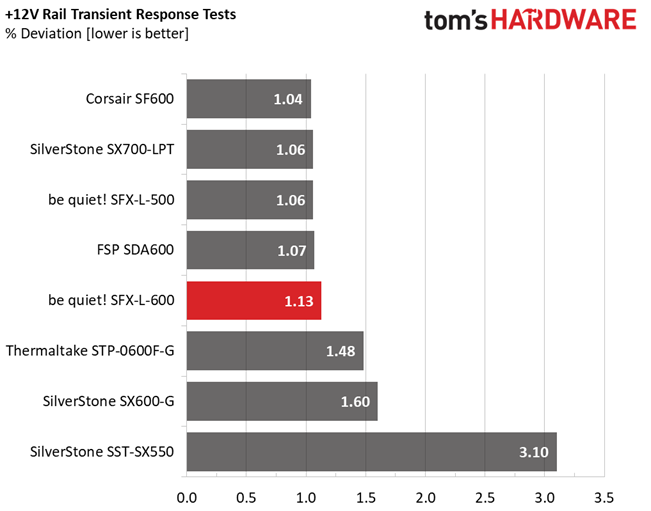



It would be nice if the +12V rail was closer to 1% in these tests. However, it looks like there wasn't enough space for the components that would have been required to get there. The 5V and 5VSB rails achieve decent performance, while the 3.3V rail registers high deviations, although it still passes our tests successfully.
Get Tom's Hardware's best news and in-depth reviews, straight to your inbox.
Here are the oscilloscope screenshots we took during Advanced Transient Response Testing:
Transient Response At 20 Percent Load – 200ms
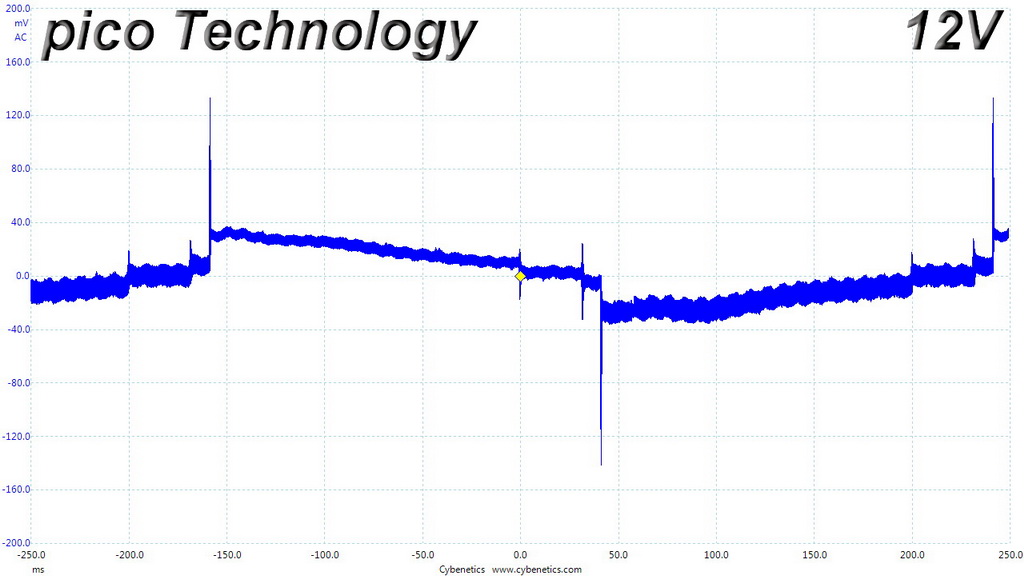
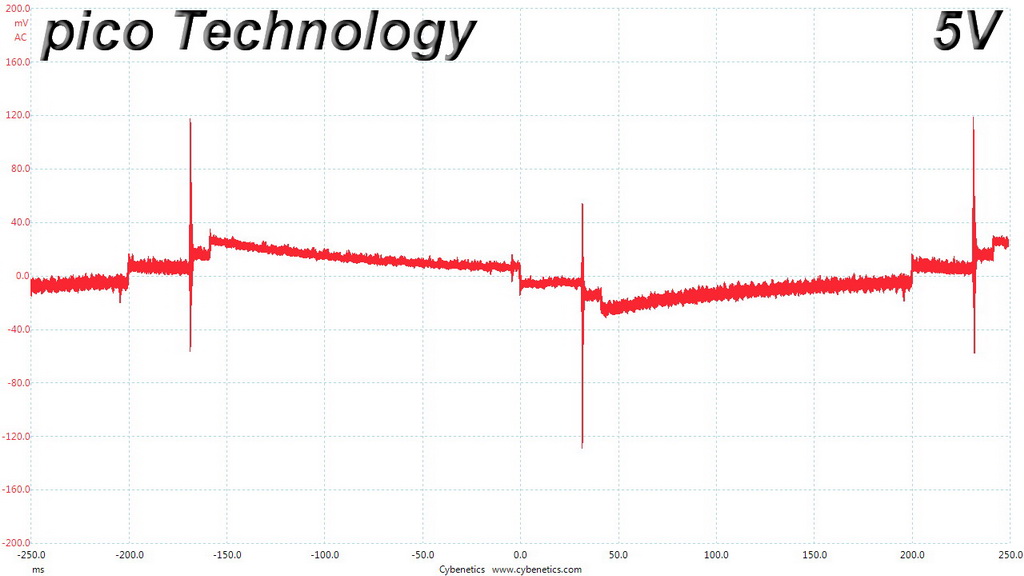


Transient Response At 20 Percent Load – 20ms


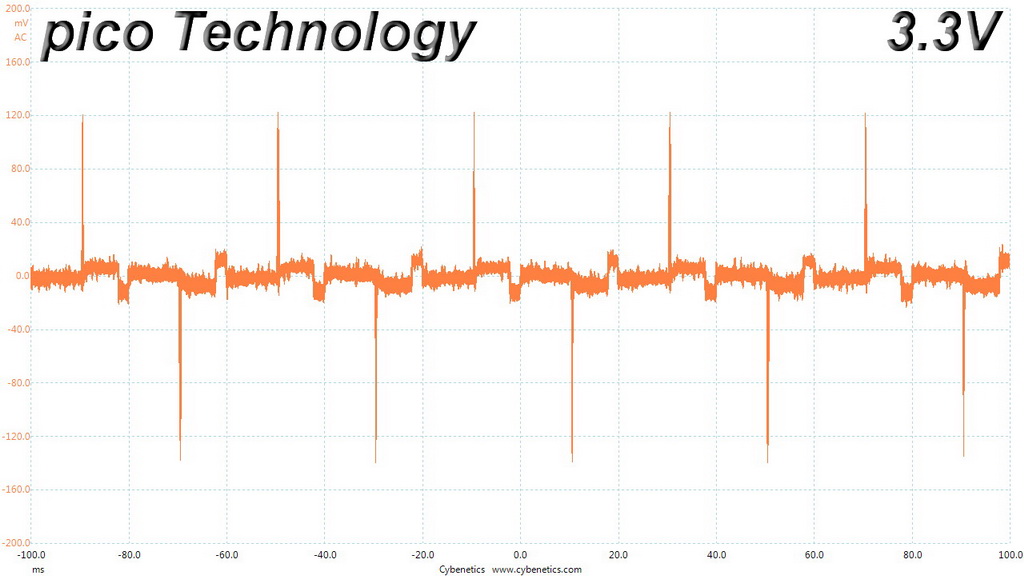

Transient Response At 20 Percent Load – 1ms




Transient Response At 50 Percent Load – 200ms
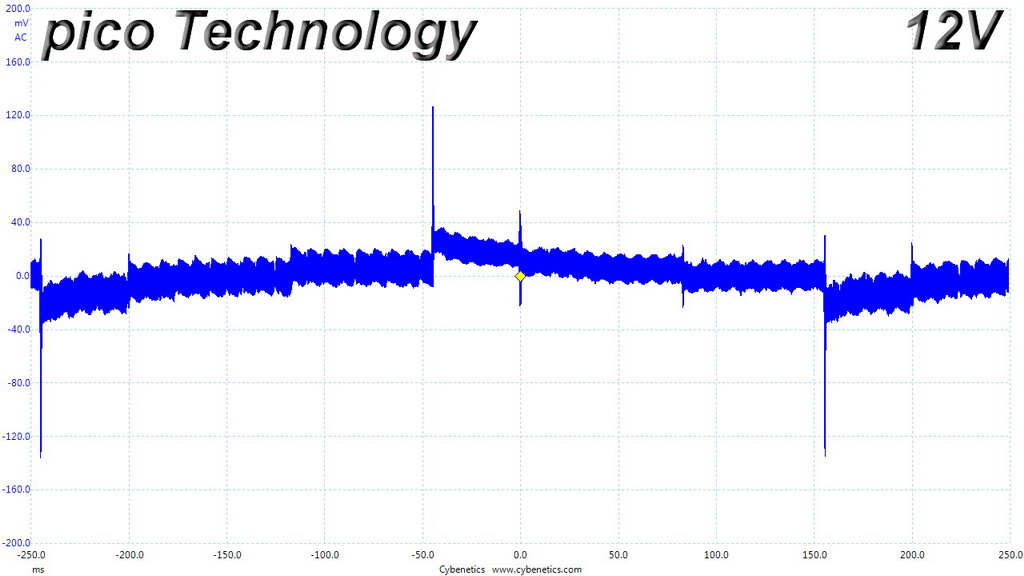



Transient Response At 50 Percent Load – 20ms




Transient Response At 50 Percent Load – 1ms



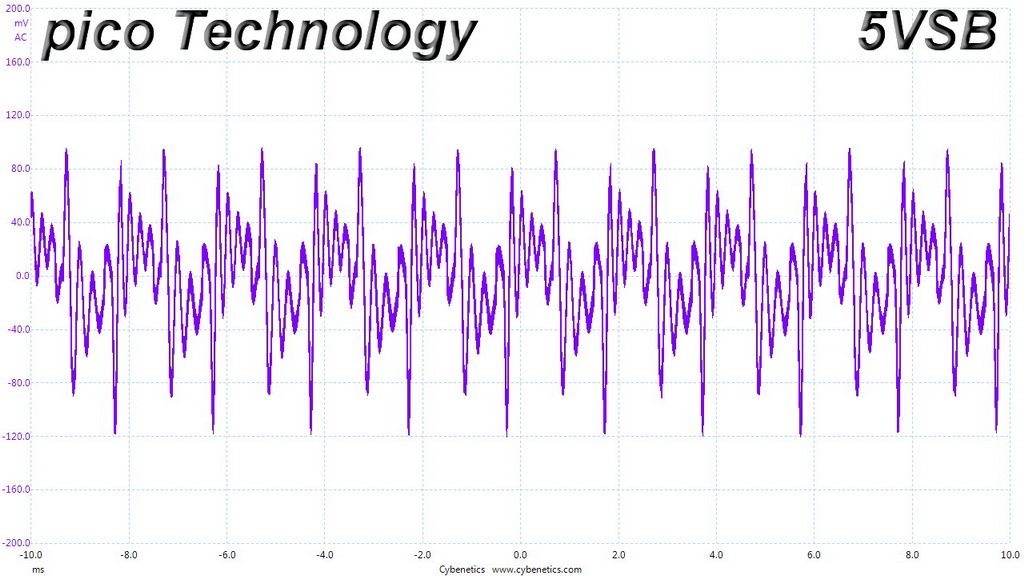
Turn-On Transient Tests
In the next set of tests, we measured the SFX L Power 600W's response in simpler transient load scenarios—during its power-on phase.
For our first measurement, we turned the PSU off, dialed in the maximum current the 5VSB rail could output, and switched it back on. In the second test, we dialed the maximum load the +12V rail could handle and started the 600W supply while it was in standby mode. In the last test, while the PSU was completely switched off (we cut off the power or switched the PSU off), we dialed the maximum load the +12V rail could handle before switching it back on from the loader and restoring power. The ATX specification states that recorded spikes on all rails should not exceed 10 percent of their nominal values (+10 percent for 12V is 13.2V, and 5.5 V for 5V).



All slopes ramp up smoothly, without any spikes or voltage overshoots. This is good performance.
MORE: Best Power Supplies
MORE: How We Test Power Supplies
MORE: All Power Supply Content
Current page: Transient Response Tests
Prev Page Cross-Load Tests & Infrared Images Next Page Ripple Measurements
Aris Mpitziopoulos is a contributing editor at Tom's Hardware, covering PSUs.
-
Aris_Mp The SF600 has higher performance. This is shown in the relative performance chart. However in the overall noise score the SF600 is much higher as well, because its fan profile gets highly aggressive once you load its minor rails. In real life conditions where the minor rails are lightly used, it is quite silent.Reply -
expert_vision You know what baffles me? How is it possible that no monitoring is offered in today PSUs ? I used to have a HighPower PSU 10 years ago that had a simple 7 segment display, showing instantaneous power draw in watts, and a 3 header pin for FAN RPM. You'd think by today that would be standard. But no, instead they put freaking RGB in everything ...Reply -
below I had bought one of them a few weeks ago and after installing in bitfenix portal case it has start to randomly make noises. I had rebuild my block two times just to make sure that there is nothing except PSU fan itself making that noise. The noise is comparably with very old HDD's or even Floppy crunching, its super annoying and only appears in PSU working state (when fan at the bottom) and mostly on high load, also noise could be very loudReply
Also I have found some review on Spanish (I think) from amazon about this PSU and customer have exactly the same issue, so looks like it could be design problem.
This PSU is a winner of most comparisons an reviews everywhere and I very dissapointed that none of reviewers couldn't find such awfull issue for quiet PSU.
Also it should be a shame for company named 'be quiet' that it's 'silent wings' in that PSU making that horrible noises.